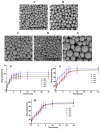Current State and Promising Opportunities on Pharmaceutical Approaches in the Treatment of Polymicrobial Diseases
- PMID: 33672615
- PMCID: PMC7924209
- DOI: 10.3390/pathogens10020245
Current State and Promising Opportunities on Pharmaceutical Approaches in the Treatment of Polymicrobial Diseases
Abstract
In recent years, the emergence of newly identified acute and chronic infectious disorders caused by diverse combinations of pathogens, termed polymicrobial diseases, has had catastrophic consequences for humans. Antimicrobial agents have been clinically proven to be effective in the pharmacological treatment of polymicrobial diseases. Unfortunately, an increasing trend in the emergence of multi-drug-resistant pathogens and limited options for delivery of antimicrobial drugs might seriously impact humans' efforts to combat polymicrobial diseases in the coming decades. New antimicrobial agents with novel mechanism(s) of action and new pharmaceutical formulations or delivery systems to target infected sites are urgently required. In this review, we discuss the prospective use of novel antimicrobial compounds isolated from natural products to treat polymicrobial infections, mainly via mechanisms related to inhibition of biofilm formation. Drug-delivery systems developed to deliver antimicrobial compounds to both intracellular and extracellular pathogens are discussed. We further discuss the effectiveness of several biofilm-targeted delivery strategies to eliminate polymicrobial biofilms. At the end, we review the applications and promising opportunities for various drug-delivery systems, when compared to conventional antimicrobial therapy, as a pharmacological means to treat polymicrobial diseases.
Keywords: antimicrobials; biofilms; drug delivery system; natural products; pharmacological approach; polymicrobial diseases.
Conflict of interest statement
The authors declare no conflict of interest.
Figures




Similar articles
-
[Development of antituberculous drugs: current status and future prospects].Kekkaku. 2006 Dec;81(12):753-74. Kekkaku. 2006. PMID: 17240921 Review. Japanese.
-
Searching for new strategies against polymicrobial biofilm infections: guanylated polymethacrylates kill mixed fungal/bacterial biofilms.J Antimicrob Chemother. 2016 Feb;71(2):413-21. doi: 10.1093/jac/dkv334. Epub 2015 Oct 21. J Antimicrob Chemother. 2016. PMID: 26490013
-
"It Takes a Village": Mechanisms Underlying Antimicrobial Recalcitrance of Polymicrobial Biofilms.J Bacteriol. 2019 Dec 6;202(1):e00530-19. doi: 10.1128/JB.00530-19. Print 2019 Dec 6. J Bacteriol. 2019. PMID: 31548277 Free PMC article. Review.
-
Antibiofilm activity of chitosan/epsilon-poly-L-lysine hydrogels in a porcine ex vivo skin wound polymicrobial biofilm model.Wound Repair Regen. 2021 Mar;29(2):316-326. doi: 10.1111/wrr.12890. Epub 2021 Jan 22. Wound Repair Regen. 2021. PMID: 33480137
-
Strategies for controlling polymicrobial biofilms: A focus on antibiofilm agents.Int J Antimicrob Agents. 2024 Aug;64(2):107243. doi: 10.1016/j.ijantimicag.2024.107243. Epub 2024 Jun 20. Int J Antimicrob Agents. 2024. PMID: 38908533 Review.
Cited by
-
Efficacy of Phytochemicals Derived from Avicennia officinalis for the Management of COVID-19: A Combined In Silico and Biochemical Study.Molecules. 2021 Apr 12;26(8):2210. doi: 10.3390/molecules26082210. Molecules. 2021. PMID: 33921289 Free PMC article.
-
Bromelain a Potential Bioactive Compound: A Comprehensive Overview from a Pharmacological Perspective.Life (Basel). 2021 Apr 6;11(4):317. doi: 10.3390/life11040317. Life (Basel). 2021. PMID: 33917319 Free PMC article. Review.
-
Advances in bacteriophage-mediated strategies for combating polymicrobial biofilms.Front Microbiol. 2024 Jan 5;14:1320345. doi: 10.3389/fmicb.2023.1320345. eCollection 2023. Front Microbiol. 2024. PMID: 38249486 Free PMC article. Review.
-
Pharmaceutical Prospects of Bee Products: Special Focus on Anticancer, Antibacterial, Antiviral, and Antiparasitic Properties.Antibiotics (Basel). 2021 Jul 6;10(7):822. doi: 10.3390/antibiotics10070822. Antibiotics (Basel). 2021. PMID: 34356743 Free PMC article. Review.
-
Development and Characterization of Pharmaceutical Systems Containing Rifampicin.Pharmaceutics. 2023 Jan 5;15(1):198. doi: 10.3390/pharmaceutics15010198. Pharmaceutics. 2023. PMID: 36678827 Free PMC article.
References
-
- Manson J.M., Rauch M., Gilmore M.S. The Commensal Microbiology of the Gastrointestinal Tract. In: Huffnagle G.B., Noverr M.C., editors. GI Microbiota and Regulation of the Immune System. Springer; New York, NY, USA: 2008. pp. 15–28. - DOI
Publication types
LinkOut - more resources
Full Text Sources
Other Literature Sources
Molecular Biology Databases

